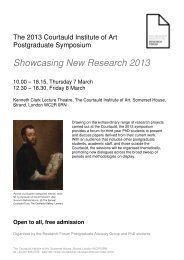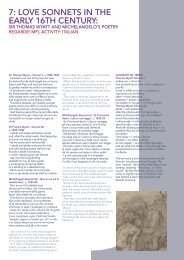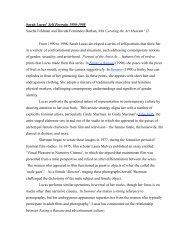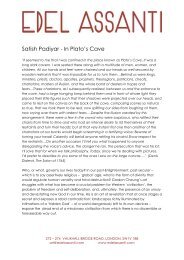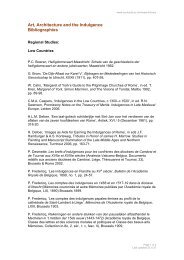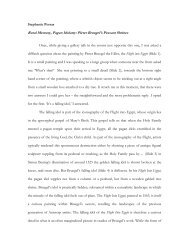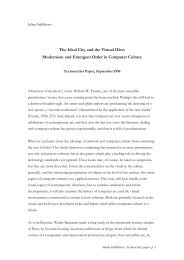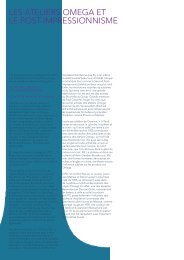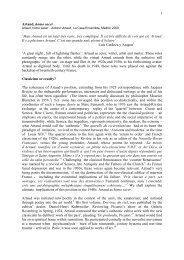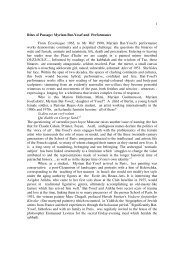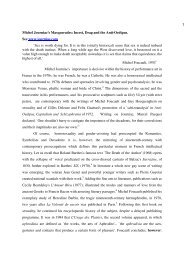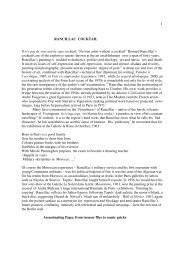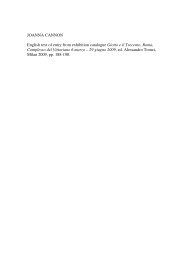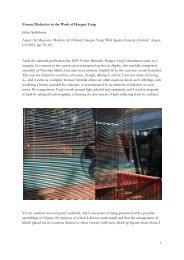Iluna gordelekuan/ Oscuridad en el refugio - The Courtauld Institute ...
Iluna gordelekuan/ Oscuridad en el refugio - The Courtauld Institute ...
Iluna gordelekuan/ Oscuridad en el refugio - The Courtauld Institute ...
You also want an ePaper? Increase the reach of your titles
YUMPU automatically turns print PDFs into web optimized ePapers that Google loves.
woman’. 2<br />
Philip H<strong>en</strong>dy described some of Moore’s creations in similar terms as having a<br />
‘monstrous anatomy’. 3<br />
<strong>The</strong>re was a widespread assumption that these works in some way<br />
reduced humanity to a lower form of life, immobilized it and ev<strong>en</strong> brought it to a death-like<br />
state. 4 George Digby set up a basic opposition betwe<strong>en</strong> the ideals of the modern world, which<br />
prize individuality and int<strong>el</strong>lect, and the ‘massive and summary’ r<strong>en</strong>dering of figures by<br />
Moore with their limbs ‘stiff<strong>en</strong>ed and distorted’, their heads like stumps. Articulation and<br />
movem<strong>en</strong>t in these figures seemed impossible, he claimed. <strong>The</strong> work appeared primitive, and<br />
the reading of these heads was clearly se<strong>en</strong> as a b<strong>el</strong>ittling of the int<strong>el</strong>lect. <strong>The</strong> distortions of<br />
the body were so extreme that Moore had created ‘atavistic sub-human’ beings which are like<br />
‘great petrified fossils’: ‘<strong>The</strong> emphasis is not only on the static, but ev<strong>en</strong>, in these reclining<br />
figures, on the moribund. Limbs disappear into ridges of stone or metal, holes appear where<br />
vital parts once throbbed, oft<strong>en</strong> only a suggestion of anatomy remains amid the haphazard<br />
lineam<strong>en</strong>ts of inorganic matter, around which remote but subtle human suggestions still<br />
hover.’ 5<br />
Digby, however, was a supporter of Moore’s work. He w<strong>en</strong>t on to write that art was<br />
fundam<strong>en</strong>tally concerned with unconscious and non-personal manifestations of the mind. In<br />
common with many critics, he made refer<strong>en</strong>ce to the supposedly Jungian action of these<br />
pieces on the viewer. In the stunted heads there was ‘the motion and the life of the Zombi;<br />
will and consciousness is not theirs, but the driving force of unlimited, untransformed <strong>en</strong>ergy<br />
passes through them.’ Moore’s work expressed a strongly atavistic attitude, for the chief<br />
characteristic of his art was a strongly regressive urge which acted against the rational <strong>en</strong>ds of<br />
society. It is possible that this attitude reflected an unconscious attitude in our culture ‘the<br />
shadow of a new point of view which is rising into consciousness.’ 6<br />
Similarly Nikolaus Pevsner thought that Moore nearly always reduced natural<br />
appearances to conveying a vitality ‘lower’ than that of the animal or human body: his work<br />
was suggestive of ‘lower life, of the blind growth of roots, of vertebrae or ev<strong>en</strong> cartilage, or<br />
of the passive suffering of the pebble gradually eroded by the slow motion of water and<br />
sand.’ Man was never fit to act, limbs were tapered like stumps, heads excessiv<strong>el</strong>y small,<br />
there was a groping towards the <strong>el</strong>em<strong>en</strong>tary and the pre-conscious. 7



